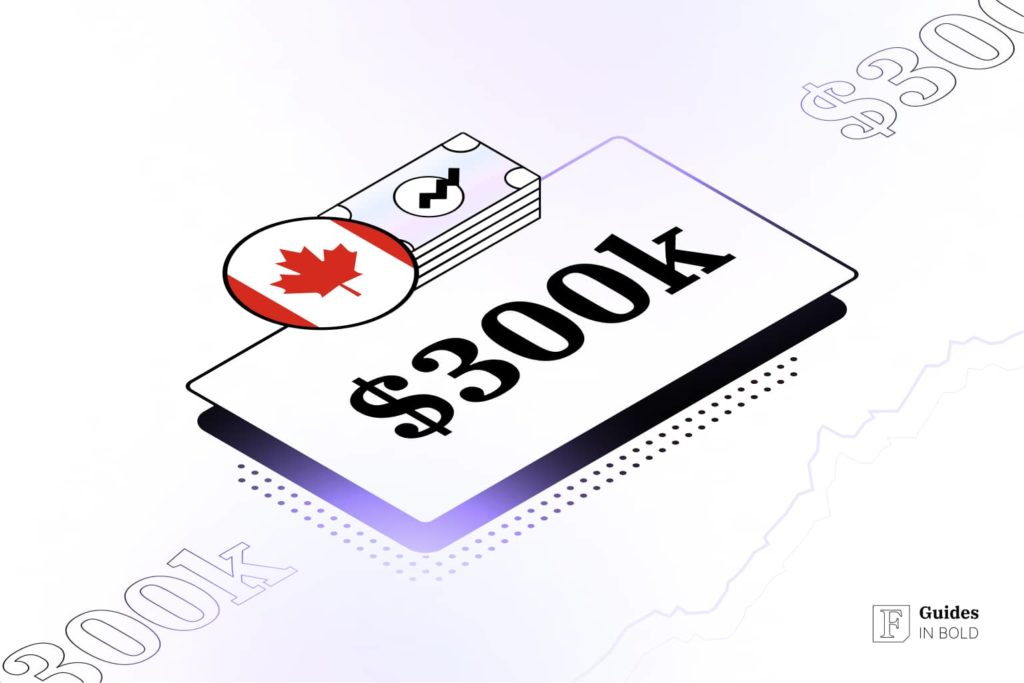Summary: This guide will detail the five best strategies for investing $300k CAD in Canada. Additionally, we will explore the pros and cons of each approach, things to consider before investing, and Interactive Brokers – our recommendation for the most suitable investing service in Canada.
Best Platform for Worldwide Stock Trading & Investing
-
Highly trusted multi-asset broker with clients in over 200 countries
-
Trade on 150 markets globally from a single platform (stocks, ETFs, futures, currencies, crypto & more)
-
Low commissions starting at $0 with no platform fees or account minimums
-
Easily fund your account and trade assets in 26 currencies
-
IBKR pays up to 4.58% interest on cash balances of $10k or more
Before you start investing
We highly recommend you do two things before you spend any money. Since investing is a serious and responsible business, you should start from a solid financial position. To accomplish this, make sure you:
- Create an emergency fund: An emergency fund creates a buffer for surprise expenses like medical bills or covering job loss. Having at least three to six months of living costs covered with the fund should suffice;
- Pay off high-interest debt: Debt with high-interest rates can annul or even cost you more than you can earn. Before investing, ensure you have no remaining credit card, payday, or other loans to burden your potential earnings. Besides improving your net income, this also helps with risk management. Low-interest debts like mortgages should not be that harmful to your investment.
Once you have cleared these out, you can embark on the investing journey as you have created a solid foundation that should boost your chances of success in the long term.
Bear in mind before you continue
Best ways to invest $300k in Canada
Arguably, the best way to spend 300k CAD is to invest. You can earn greater returns or create a cozily large savings account with the right choice (or combination) of investment commodities and proper portfolio management. However, there is no single best path to profit: your preferences depend on your investing goals and style.
Let us explore the most optimal ways to invest $300k in Canada:
- Stock market;
- Dividend stocks;
- Index funds and ETFs;
- Real estate — REITs;
- Fixed income;
How to invest $300k in Canada #1: Stock market
Investment type: Long-term growth
Risk Level: Varies
Recommended broker: Interactive Brokers
Best Platform for Worldwide Stock Trading & Investing
-
Highly trusted multi-asset broker with clients in over 200 countries
-
Trade on 150 markets globally from a single platform (stocks, ETFs, futures, currencies, crypto & more)
-
Low commissions starting at $0 with no platform fees or account minimums
-
Easily fund your account and trade assets in 26 currencies
-
IBKR pays up to 4.58% interest on cash balances of $10k or more
Investing in the stock market is one of the best long-term ways to accumulate wealth. Historically, stocks and shares have performed better than most investment assets, including bonds, gold, silver, oil, wine, and even real estate.
Stocks are a long-term growth commodity, and they tend to have years during which their value drops. However, the average change in value over years and decades is positive by quite a margin. For example, despite wild swings like an increase of +26.89% in 2021 and a failure of -19.44% the following year, the S&P 500 index has maintained average annual returns of 10.21% since it was established in 1957.

On the other hand, stocks can have relatively high risk due to the market’s price volatility. To successfully invest in stocks, you have to be comfortable with the shifting nature of such an investment and be risk-tolerant. However, if this is not the case, you will likely find other options in this guide more suitable.
Note
Pros and cons of investing in the stock market in Canada

Pros
- High returns: Stocks have greater potential average returns than most traditional investment assets;
- Liquidity: Investors can buy and sell shares quickly and without issues;
- Low barrier of entry: You do not need a large sum to start buying stocks, so you do not have to put all 300k in your stock portfolio. With commission-free trading and no-minimum accounts, stocks can be purchased for as little as several bucks;
- Build long-term wealth: Stocks tend to perform well in the long run, and a solid portfolio with proper management can build significant wealth.

Cons
- Returns are not guaranteed: No investment has guarantees of success. Stocks do perform better than most other assets, but they remain vulnerable to economic failures;
- No short-term gains: Investing in stocks will take years to show results. You cannot game the market with stock investment;
- Volatility: Stock investors must be mentally prepared for continuous alternations between soaring and free-falling prices, which requires mental and emotional fortitude;
- Time and effort investment: Stocks are an active form of investing, meaning they take time and effort to manage, e.g., regular fundamental and technical analysis.
How to invest $300k in Canada #2: Dividend stocks
Investment type: Long-term growth and passive income
Risk Level: Varies
Recommended broker: Interactive Brokers
Best Platform for Worldwide Stock Trading & Investing
-
Highly trusted multi-asset broker with clients in over 200 countries
-
Trade on 150 markets globally from a single platform (stocks, ETFs, futures, currencies, crypto & more)
-
Low commissions starting at $0 with no platform fees or account minimums
-
Easily fund your account and trade assets in 26 currencies
-
IBKR pays up to 4.58% interest on cash balances of $10k or more
Assigning a portion of $300k to dividend stocks is a smart way to establish a source of passive income. Dividends are a portion of profits a company gives its shareholders, usually in cash. You are free to spend or reinvest this income as you please.
You can recognize the best dividend-paying companies by a steady increase in dividend payments over time. This reflects financial vitality and a stable pace of growth. Other factors to consider include historical performance, free cash flow, and the company’s plans for the future.
The ultimate dividend stock has both the stock price and dividend payouts rising. Reinvesting the dividends back into your portfolio can bring compounding returns.
Important
How to invest $300k in Canada #3: Index funds and ETFs
Investment type: Long-term growth
Risk Level: Low (varies between funds)
Recommended broker: Interactive Brokers
Best Platform for Worldwide Stock Trading & Investing
-
Highly trusted multi-asset broker with clients in over 200 countries
-
Trade on 150 markets globally from a single platform (stocks, ETFs, futures, currencies, crypto & more)
-
Low commissions starting at $0 with no platform fees or account minimums
-
Easily fund your account and trade assets in 26 currencies
-
IBKR pays up to 4.58% interest on cash balances of $10k or more
Index funds and exchange-traded funds (ETFs) are financial assets that aim to reflect the performance of a given financial market index, like the S&P 500. Rather than trying to beat the market index, the fund seeks to mimic its outcomes as much as possible.
Investing in an index fund represents a simple way for investors to diversify their portfolios cheaply. Furthermore, this reduces the overall risk as they spread their investment across hundreds of various securities through a single market access point.
These assets are perfect for a long-term, passive approach to investing. If you decide to rely on index funds and ETFs, you will most likely employ a buy-and-hold strategy. It takes more time than some other investments on this list but takes little to no active management by investors.
In Canada, the most popular and tracked indexes are:
- BMO S&P/TSX Capped Composite – the largest Canadian companies trading on the Toronto Stock Exchange (TSX);
- iShares S&P/TSX 60 – the 60 largest stocks by market cap traded on the TSX;
- FTSE Canada All Cap – small, medium, and large Canadian stocks by market cap.
You might also consider investing in the three most broadly tracked indexes in the US, which are:
- The S&P 500;
- Dow Jones Industrial Average;
- Nasdaq Composite.
Pros and cons of investing in index funds and ETFs in Canada

Pros
- Diversification: Spreading your investment across different industries and sectors by investing in an index fund or ETF helps you mitigate overall risk;
- Low fees: Passive investment assets such as index funds and ETFs have significantly fewer transactions involved, reducing trading and maintenance costs and fees;
- Easy access: The stock market is easy and inexpensive to access using a platform like Interactive Brokers, which is of particular use to novice investors;
- Liquidity: These assets can be bought and sold quickly and easily;
- Transparency: Index funds and ETFs are traded publicly, which enables you to check the performance of each stock in a fund;
- Convenience: Investing in a fund rather than in each individual stock can save you substantial sums of money and time;
- Simplicity: Monitoring a passive investing asset such as an index fund or ETF spares the trader from emotional turbulences due to massive swings in the price of individual stocks. Also, you need only monitor one index rather than every stock.

Cons
- Limited control: When you invest in index funds and ETFs, you have no control over which individual companies you invest in;
- Volatility: How index funds perform is tied to their benchmark indexes. In case of a plunge in the market, the index funds will likely follow suit;
- Slow gains: The buy-and-hold strategy brings its returns in the long run, but it is a slow approach with limitations on the amounts you can obtain from your initial investment. The downside of low risk is lower returns.
How to invest $300k in Canada #4: Real estate (REITs)
Investment type: Long-term growth, passive income
Risk Level: Medium
Recommended broker: Interactive Brokers
Best Platform for Worldwide Stock Trading & Investing
-
Highly trusted multi-asset broker with clients in over 200 countries
-
Trade on 150 markets globally from a single platform (stocks, ETFs, futures, currencies, crypto & more)
-
Low commissions starting at $0 with no platform fees or account minimums
-
Easily fund your account and trade assets in 26 currencies
-
IBKR pays up to 4.58% interest on cash balances of $10k or more
Investing in real estate property is one of the most recognizable investment forms. However, as Canadian real estate experiences a steady recovery after the 2022 market crash, some investors have become wary of management, upkeep, and direct, hands-on involvement in the property.
REITs (real estate investment trusts) are an attractive alternative to investing in physical property. They provide exposure to the market without the hassle of owning and managing property. In other words, REITs comprise companies that possess, finance, or maintain income-producing real estate across various sectors. These trusts are listed on major exchanges, allowing the general public to invest directly.
Additionally, Canadian law mandates REITs to distribute at least 90% of their taxable income to stakeholders annually, which provides a lucrative passive income source for investors.
Pros and cons of investing in Canadian real estate through REITs

Pros
- High dividend yield: The law requires REITs to distribute at least 90% of income to shareholders, making their dividend yields among the highest on the market;
- Diversification: REITs allow a simple and easy way to diversify your portfolio without having to manage them actively;
- Liquidity: REITs are publicly listed on stock exchanges and can be bought or sold quickly on the market, unlike actual physical property;
- Solid returns: REITS can have annual returns going above those of the S&P 500;
- Exposure to the real estate market: Investing in REITS provides access to the real estate market without the management chores associated with owning property.

Cons
- Slow growth: Since at least 90% of income is converted into dividends, less than 10% of REITs income gets reinvested into further development;
- Interest rate sensitivity: REITs expand chiefly through external debt and equity capital, leaving them vulnerable to an increase in interest rates;
- Sector concentration risk: REITs that focus on a single property sector become vulnerable to sector-specific events, which the global pandemic showed with the hospitality sector in 2020.
- Tax-eligibility: REIT dividends are susceptible to taxes as regular income.
How to invest $300k in Canada #5: Fixed income
Investment type: Conservative investing, retirement
Risk Level: Low
Fixed-income investments are debt securities offering regular, fixed, or predetermined returns over an agreed-upon time. The typical case is for investors to lend money to the government or a regulated company and receive a source of interest returns. Once the agreement concludes, you get your principal returned.
Some common types of fixed-income investments in Canada include:
- Government, provincial, and Federal Crown bonds: Fully guaranteed by the government, these bonds are virtually risk-free if held until the end of the agreement. You can also sell them on the market, and the agreement terms range from one year to 30 years;
- Stripped bonds: These bonds are stripped of their interest coupons and made into individual notes with set maturity dates. Purchased at face value with a discount, they represent money compounded at a fixed rate, eliminating the need to reinvest;
- Mortgage-backed securities: Ideal for risk-wary investors, mortgage-backed securities represent an ownership interest of mortgages pooled together. Monthly payments represent the interest and principal payments of these mortgages. The agreed terms range from one to ten years, and the Canadian Mortgage and Housing Corporation (CMHC) fully guarantees them.
The fixed-income investments provide much lower yields when compared with the potential of stocks, ETFs, or REITs. Still, their advantage is the negligibly low or even non-existent risk due to government guarantees. Furthermore, the reliable income is particularly attractive to conservative investors and early retirees.
Pros and cons of fixed-income investments in Canada

Pros
- Stability: Fixed-income investments are much stabler assets than other commodities, such as equities, which suits risk-averse investors;
- Predictability: As financial authorities guarantee most fixed-income investments, the steady streams of revenue provide regular and predictable income;
- Diversification: Fixed-income’s virtually non-existent risk is perfect for diversifying portfolios and reducing overall investing hazards;
- Safety of initial investment: The only way to lose your principal investment is by withdrawing early: every other case will return at least your principal intact.

Cons
- Low returns: Riskless investment translates to low yields: significantly lower than, e.g., stocks or REITs;
- Hypersensitivity to interest rates: Fixed-rate bonds that do not account for inflation can suffer from rising interest rates;
- Inflation risk: High inflation can lower the value of future monthly payments;
- Limited growth: Including fixed-income lowers both your portfolio’s overall risk and the potential growth rate.
How to safely invest $300k in Canada — things to consider
A sum of 300k CAD is not something anyone is willing to squander, lose, or have stolen from them. To prevent such outcomes, you need to do the following:
- Diversify: It is much easier to manage your comfortable level of risk across a broader portfolio. The more varied assets, the better. In case of a financial instrument crashing, the damage to your portfolio will be less the more other assets you hold in it;
- Spread out your investments: Investing all $300k at once can significantly shake the market. Instead of lump-sum purchases, think about using the dollar-cost averaging (DCA) approach.
- Stay wary of fraud: New forgeries, false documents, and pseudo-authentic websites and brands tend to be significant sources of fraud that can rob you of your property. Con men stalk every industry, so remain careful. If it sounds too good to be true, it probably is. Check with the Financial Consumer Agency of Canada (FCAC) if anything looks suspicious.
In conclusion
When you decide to invest as much as $300k in Canada, we recommend you consider building wealth for the long run. This does not mean that you should stay clear of short-term gains, just that having a diverse portfolio strikes a perfect balance between keeping safe and keeping in the black.
This amount of money opens a lot of access points to various lucrative markets, but remember to adhere to the guidelines given in this guide to stay safe and do the necessary preparations prior to investing any money.
Nonetheless, before you put that money to work, take care of the basics, like paying off any existing high-interest debts or building an emergency fund. You might go straight to $500k with a bit of luck and patience. And if all this sounds a bit overwhelming, you might want to read one of our guides for humbler sums, like $10k or even $5k.
Disclaimer: The content on this site should not be considered investment advice. Investing is speculative. When investing, your capital is at risk.
FAQs about how to invest $300k in Canada
How to invest $300k in Canada?
Your best bet for investing $300k is distributing it through various financial assets, such as stocks, index funds, real estate, and fixed income.
How to invest $300k to make $1 million in Canada?
The answer depends on your investing style and the risk you are willing to take. Quicker methods, like stocks, tend to have higher risks, while slower processes have more likely outcomes, like fixed-income investments. The right combination of these two might be vital to this investing journey.
What is the best way to invest $300k safely?
The best way to invest $300k safely depends on your age, personality, risk aversion, and financial goals. A properly diversified portfolio will mix several investment instruments with different risk levels. Regardless, ensure you have paid off any high-interest debt before investing.
How to invest $300k for passive income in Canada?
There are several options for investing $300k for passive income, such as index fund and ETF investing, dividend stock investing, and REITs.
How to invest $300k in real estate in Canada?
Besides investing in physical property, you can also access the real estate market by investing in REITs. This method provides all the benefits of earning a passive income through properties while dealing away with directly managing the properties that come with real estate ownership.
Best Platform for Worldwide Stock Trading & Investing
-
Highly trusted multi-asset broker with clients in over 200 countries
-
Trade on 150 markets globally from a single platform (stocks, ETFs, futures, currencies, crypto & more)
-
Low commissions starting at $0 with no platform fees or account minimums
-
Easily fund your account and trade assets in 26 currencies
-
IBKR pays up to 4.58% interest on cash balances of $10k or more




